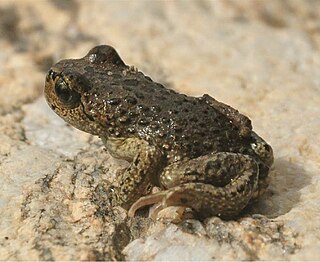
Scutiger boulengeri is a species of toad in the family Megophryidae. It is found in Nepal, India (Sikkim) and western China. A healthy population has been found at an elevation of 5,270 m (17,290 ft) in one of the lakes in the Gurudongmar Lake complex in Sikkimese Himalaya. This is one of the highest elevations where amphibians have ever been recorded.

Scinax boulengeri is a species of frog in the family Hylidae. It is found in Colombia, Costa Rica, Nicaragua, Panama, and possibly Honduras. Its natural habitats are subtropical or tropical moist lowland forests, intermittent freshwater marshes, pastureland, plantations, rural gardens, and urban areas. It has been found as high as 600 meters above sea level.
Leptopelis boulengeri is a species of frog in the family Arthroleptidae. It is found in southeastern Nigeria, southern Cameroon, Equatorial Guinea, Gabon, Republic of the Congo, and western Democratic Republic of the Congo. It is expected to be found in the Central African Republic and the Cabinda Enclave of Angola. Common name Victoria forest treefrog has been coined for it, apparently in reference to its type locality, "Victoria, Kamerun", now known as Limbe.

The Tai forest tree frog, Leptopelis occidentalis, is a species of frog in the family Arthroleptidae. It is found in Liberia, southern Ivory Coast, and Ghana. Records from Nigeria are controversial and may refer to other species, possibly Leptopelis boulengeri.

Cryptobatrachus boulengeri, also known as Boulenger's backpack frog, is a species of frogs in the family Hemiphractidae. It is endemic to Sierra Nevada de Santa Marta in northern Colombia. The specific name honours George Albert Boulenger, an eminent herpetologist.
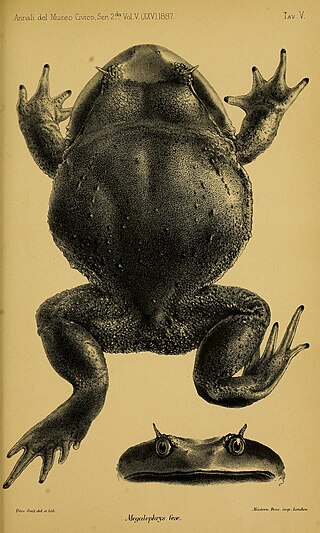
Brachytarsophrys feae is a species of amphibian in the family Megophryidae. It is found in southern China and northern Myanmar, Thailand, and Vietnam; it is likely to occur in Laos. The specific name feae honors Leonardo Fea, an Italian explorer, zoologist, and naturalist.
Quasipaa yei, or Ye's spiny-vented frog, is a species of frog in the family Dicroglossidae. It is endemic to China where it is known from the Dabie Mountains that straddle the border between Hubei, Henan, and Anhui provinces. Its type locality is in Shengcheng County in Jiyuan City, Henan. Its natural habitats are temperate rivers with surrounding forests. It is potentially threatened by habitat loss.
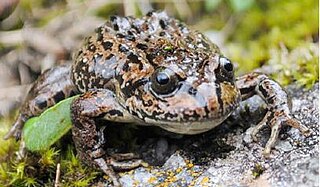
Nanorana pleskei is a species of frog in the family Dicroglossidae. Until recently it has been only known from southwestern/central western China from elevations between 3,300–4,500 m (10,800–14,800 ft), but there is now one record also from Bhutan. Notice, however, that earlier records outside China have turned out to be misidentifications.
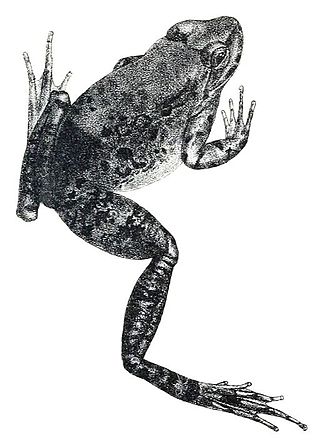
Nanorana blanfordii is a species of frog in the family Dicroglossidae. It is found in northeastern India, southern Tibet (China), and eastern Nepal, and likely in the adjacent western Bhutan. The specific name blanfordii honours William Thomas Blandford, a British geologist and zoologist.

Quasipaa exilispinosa is a species of frog in the family Dicroglossidae. It is known under many common names, including Hong Kong spiny frog, common spiny frog, lesser spiny frog, little spiny frog, and Hong Kong paa frog. It has a patchy distribution in southern China including Hong Kong. Its natural habitats are subtropical hill streams in forests or shrublands, and sometimes also seepages, stream-fed marshes, and forests. It is threatened by over-collecting for human consumption and by habitat loss.
Quasipaa fasciculispina is a species of frog in the family Dicroglossidae. It is known under many common names: spiny-breasted giant frog, spiny-breasted frog, spine-glanded mountain frog, and Thai paa frog. It is found in the Cardamom Mountains in southwestern Cambodia and eastern Thailand. It is found in on near fast-flowing mountain streams in tropical evergreen forests. It is threatened by collecting for human consumption and by habitat loss.
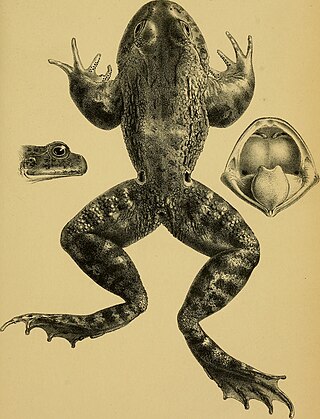
Nanorana feae is a species of frog in the family Dicroglossidae. It is found in Yunnan, China, and the Kachin Hills in Myanmar. The specific name feae honors Leonardo Fea, an Italian explorer, zoologist, and naturalist. This little-known species probably inhabits hill streams in forested areas.
Quasipaa jiulongensis is a species of frog in the family Dicroglossidae. It is endemic to eastern China and only known from the mountains of southwestern Zhejiang and adjacent Fujian above 800 m (2,600 ft) elevation. Its natural habitats are hill streams. It is threatened by habitat loss due to both logging and infrastructure development as well as by collection for food.
Quasipaa robertingeri is a species of frog in the family Dicroglossidae. It is endemic to Southwest China and is known from southeastern Sichuan, Chonqing, and northern Guizhou. It is named in honor of Robert F. Inger, an American herpetologist and ichthyologist. Common name Hejiang spiny frog has been proposed for it.
Quasipaa shini is a species of frog in the family Dicroglossidae. It is endemic to southern central China. Its natural habitats are rivers in subtropical moist lowland forests and montane forest at elevations of 510–1,500 m (1,670–4,920 ft) asl. It is threatened by over-collecting for human consumption and by habitat loss.

Quasipaa spinosa is a species of frog in the family Dicroglossidae. It is known under many common names, including Chinese spiny frog, giant spiny frog, Chinese edible frog, and spiny paa frog. Its names refer to the distinctive characteristics of the species, relatively large size and the spiny chest of male frogs. Giant in frog terms only, it can nevertheless grow to lengths above 10 cm (4 in); this makes it the largest frog in Hong Kong.
Cornufer boulengeri, commonly known as Boulenger's wrinkled ground frog or Boulenger's platymantis, is a species of frog in the family Ceratobatrachidae. It is endemic to New Britain Island in the Bismarck Archipelago, Papua New Guinea. The adults live on the forest floor of lowland and foothill rain forests, whereas juveniles occur low on the vegetation. It is potentially threatened by habitat loss caused by logging.
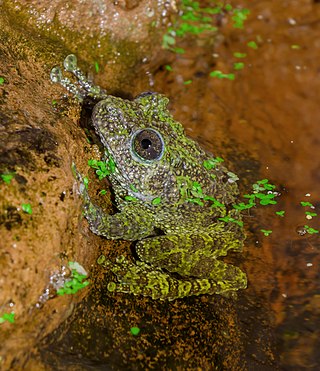
Theloderma corticale is a species of frog in the family Rhacophoridae. It is found in northern Vietnam, south–central Laos, and southern China.

Chersobius boulengeri, commonly known as the Karoo padloper or Boulenger's cape tortoise, is a species of tortoise in the family Testudinidae. The species is endemic to the Nama Karoo Region of South Africa.

Quasipaa is a genus of frogs in the family Dicroglossidae. The genus has no established common name, but many individual species are referred to as spiny frogs. They occur in East and Southeast Asia, from Thailand and Cambodia to southern and eastern China.












